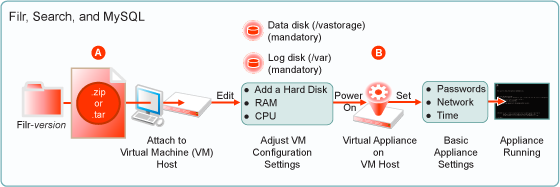2.0 Deploying Filr as a Single Appliance
IMPORTANT:The primary best practice for small Filr deployments is to ensure that a small deployment will meet your organization’s needs in the foreseeable future. A large percentage of Filr support incidents result from an organization having underestimated its file-activity workload and needing to start over with a new large, expandable deployment.
Novell strongly recommends that you thoroughly assess your organization’s needs before proceeding with a small deployment.
If you are certain that your organization’s file-activity workload will never exceed the small deployment capacity limits outlined in Figure 1-1, then you can safely proceed with a small deployment as outlined in this section.
If you are not certain, complete the planning and other instructions in this guide before proceeding.
Getting Started with Your Small Filr Deployment
The main processes involved in beginning a small deployment are illustrated and explained below.
Figure 2-1 A Small Deployment of Filr

|
Letter |
Details |
|---|---|

|
Download and deploy the software for your chosen virtualization platform as instructed in IMPORTANT:The Novell best practices recommendation is to configure a small deployment appliance with 4 CPUs and 12 GB memory. |

|
Specify the appliance’s basic configuration, which includes administrative users’ passwords, IP address settings, and the time zone and NTP time source, as instructed in These settings are common to all Novell appliances. |
Setting Up Your Small Deployment
After your Filr appliance is running on the network, you need to configure it with settings for the users and groups, the files and folders that they will access, and the permissions that they need in order to utilize Filr.
Be sure to complete the instructions in Setting Up the Filr Site
in the Filr 2.0: Installation and Configuration Guide: